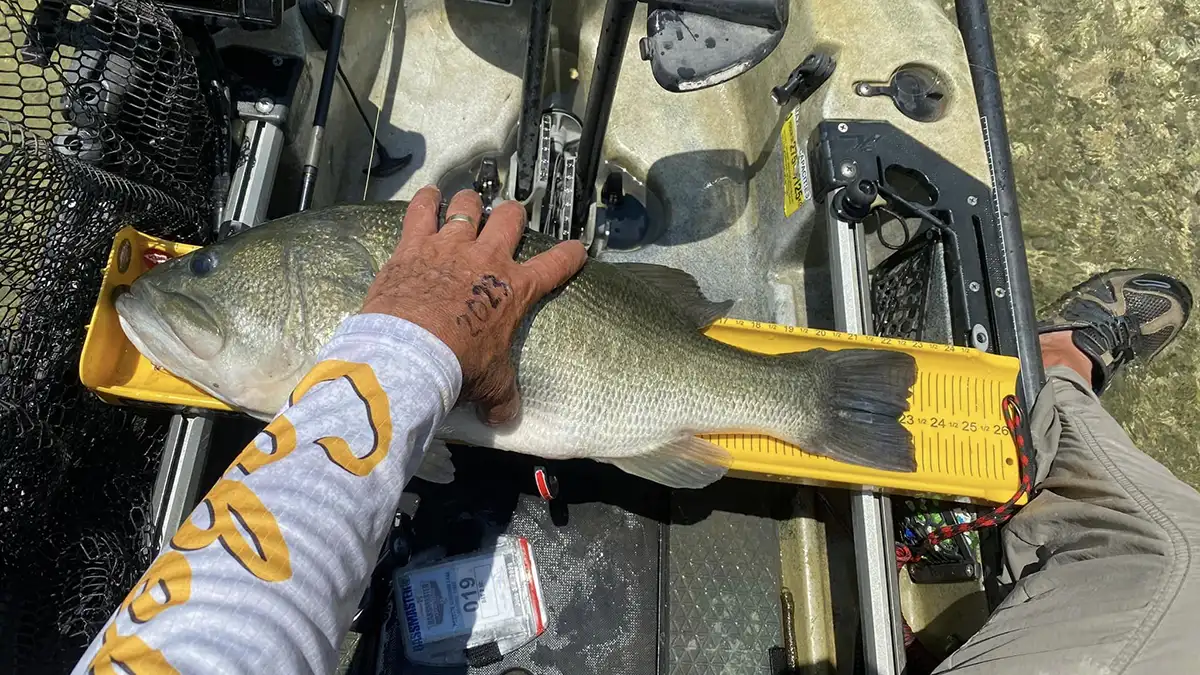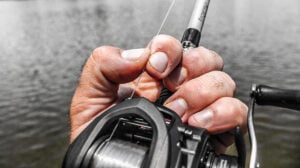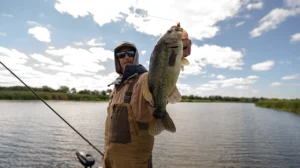So you caught a big bass. But how big? (And “how big” usually comes down to pounds and ounces — its weight.) If you have a reliable scale on hand, you can quickly answer that question. As is often the case, most anglers release their bass after quickly weighing it. But what if you don’t happen to have a reliable hand scale in your boat or tackle box?
It’s widely known in the angling community that a fish’s weight can be estimated for many species based on length and weight. For largemouth bass — not surprisingly, given the overwhelming global popularity of the species — an internet search reveals a number of charts, online calculators and mathematical formulas all designed to offer an approximation of a bass’s weight based on its length and often, but not always, its girth.
Ideally, such an internet search would show a single, universally accepted way to derive a bass’s weight from length and girth measurements. But in fact, you’ll find several approaches to making this estimate. And here’s the kicker: They all give different results — sometimes producing wildly discrepant weights for the same fish. Unfortunately, there is no silver bullet for anglers, no estimator that will guarantee an accurate result.
Online Bass Weight Calculators
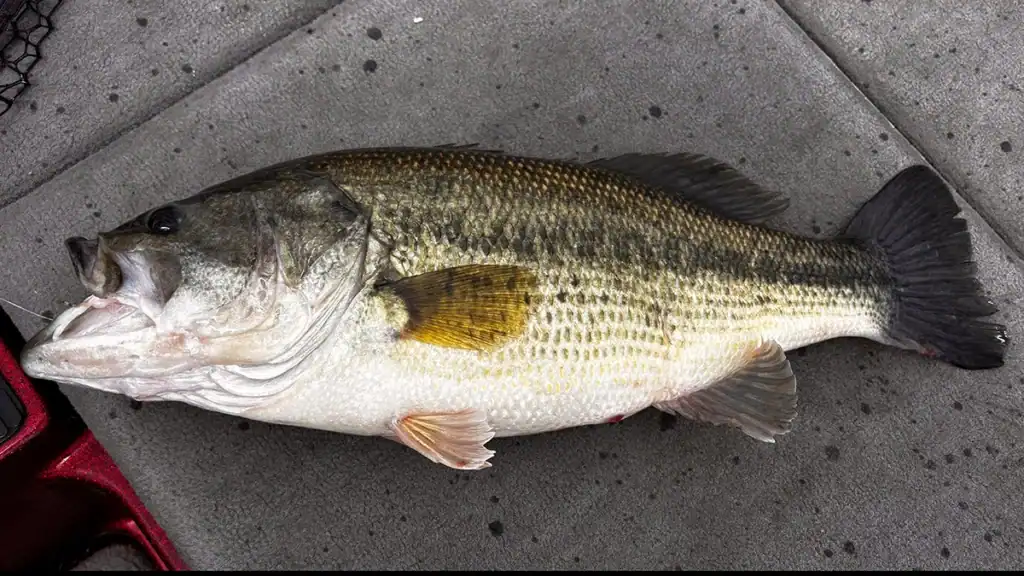
To get a better idea of these methods, below are seven options you can find online that provide the weight of a bass based on its measurements. Some offer a formula you can easily follow yourself offline, while others offer an online calculator where you plug in length and girth, while some use a simple chart of weights based on length measurement.
Note that length is most often total length (tip of mouth to end of tail, either open or closed) though I found at least one site specifying fork length for bass, which clearly will give a different result from total length. Girth is almost always taken at the point where the fish is widest (fattest).
To compare the result of each method, I went with a 23-inch bass (total length) and an 18.5-inch girth.
1. Source: Fish Calculator
- Online plug-in form uses formula: length x girth x girth / 1200
- Weight: 6.56 pounds
2. Source: In-Fisherman
- Chart based on total length (girth not factored)
- Weight: 7.17 pounds
3. Source: Texas Parks & Wildlife
- Chart based on length (no instruction on how to measure length; girth not factored)
- Weight: 7.4 pounds
Texas Parks & Wildlife Department’s Length-Weight Conversion Table for Texas Largemouth Bass
| Inches | Fractions of Inches | |||||||
| 0 | 1/8 | 1/4 | 3/8 | 1/2 | 5/8 | 3/4 | 7/8 | |
| 10 | 0.48 lb. | 0.50 lb. | 0.52 lb. | 0.54 lb. | 0.56 lb. | 0.58 lb. | 0.61 lb. | 0.63 lb. |
| 11 | 0.66 lb. | 0.68 lb. | 0.71 lb. | 0.73 lb. | 0.76 lb. | 0.79 lb. | 0.81 lb. | 0.84 lb. |
| 12 | 0.87 lb. | 0.90 lb. | 0.93 lb. | 0.97 lb. | 1.00 lb. | 1.03 lb. | 1.07 lb. | 1.10 lb. |
| 13 | 1.14 lb. | 1.17 lb. | 1.21 lb. | 1.25 lb. | 1.29 lb. | 1.32 lb. | 1.37 lb. | 1.41 lb. |
| 14 | 1.45 lb. | 1.49 lb. | 1.54 lb. | 1.58 lb. | 1.63 lb. | 1.67 lb. | 1.72 lb. | 1.77 lb. |
| 15 | 1.82 lb. | 1.87 lb. | 1.92 lb. | 1.97 lb. | 2.02 lb. | 2.08 lb. | 2.13 lb. | 2.19 lb. |
| 16 | 2.25 lb. | 2.31 lb. | 2.36 lb. | 2.42 lb. | 2.49 lb. | 2.55 lb. | 2.61 lb. | 2.68 lb. |
| 17 | 2.74 lb. | 2.81 lb. | 2.88 lb. | 2.95 lb. | 3.02 lb. | 3.09 lb. | 3.16 lb. | 3.23 lb. |
| 18 | 3.31 lb. | 3.39 lb. | 3.46 lb. | 3.54 lb. | 3.62 lb. | 3.70 lb. | 3.78 lb. | 3.87 lb. |
| 19 | 3.95 lb. | 4.04 lb. | 4.13 lb. | 4.22 lb. | 4.31 lb. | 4.40 lb. | 4.49 lb. | 4.58 lb. |
| 20 | 4.68 lb. | 4.78 lb. | 4.87 lb. | 4.97 lb. | 5.08 lb. | 5.18 lb. | 5.28 lb. | 5.39 lb. |
| 21 | 5.49 lb. | 5.60 lb. | 5.71 lb. | 5.82 lb. | 5.94 lb. | 6.05 lb. | 6.17 lb. | 6.28 lb. |
| 22 | 6.40 lb. | 6.52 lb. | 6.64 lb. | 6.77 lb. | 6.89 lb. | 7.02 lb. | 7.15 lb. | 7.28 lb. |
| 23 | 7.41 lb. | 7.54 lb. | 7.68 lb. | 7.81 lb. | 7.95 lb. | 8.09 lb. | 8.23 lb. | 8.38 lb. |
| 24 | 8.52 lb. | 8.67 lb. | 8.82 lb. | 8.97 lb. | 9.12 lb. | 9.27 lb. | 9.43 lb. | 9.59 lb. |
| 25 | 9.75 lb. | 9.91 lb. | 10.07 lb. | 10.23 lb. | 10.40 lb. | 10.57 lb. | 10.74 lb. | 10.91 lb. |
| 26 | 11.09 lb. | 11.26 lb. | 11.44 lb. | 11.62 lb. | 11.80 lb. | 11.99 lb. | 12.17 lb. | 12.36 lb. |
| 27 | 12.55 lb. | 12.74 lb. | 12.94 lb. | 13.13 lb. | 13.33 lb. | 13.53 lb. | 13.73 lb. | 13.94 lb. |
| 28 | 14.15 lb. | 14.35 lb. | 14.56 lb. | 14.78 lb. | 14.99 lb. | 15.21 lb. | 15.43 lb. | 15.65 lb. |
| 29 | 15.87 lb. | 16.10 lb. | 16.33 lb. | 16.56 lb. | 16.79 lb. | 17.03 lb. | 17.26 lb. | 17.50 lb. |
4. Source: Wisconsin Department of Natural Resources
- Provides formula: length x length x girth / 1200 (no instruction on how to measure length)
- Weight: 8.16 pounds
5. Source: Florida Fish & Wildlife Commission
- Online calculator ( plug in total length and girth)
- Weight: 8.4 pounds
6. Source: Bass Resource Guide
- Online “Fish Weight Calculator” (plug in length measurement; no instruction how to take that measurement)
- Weight: 9.59 pounds
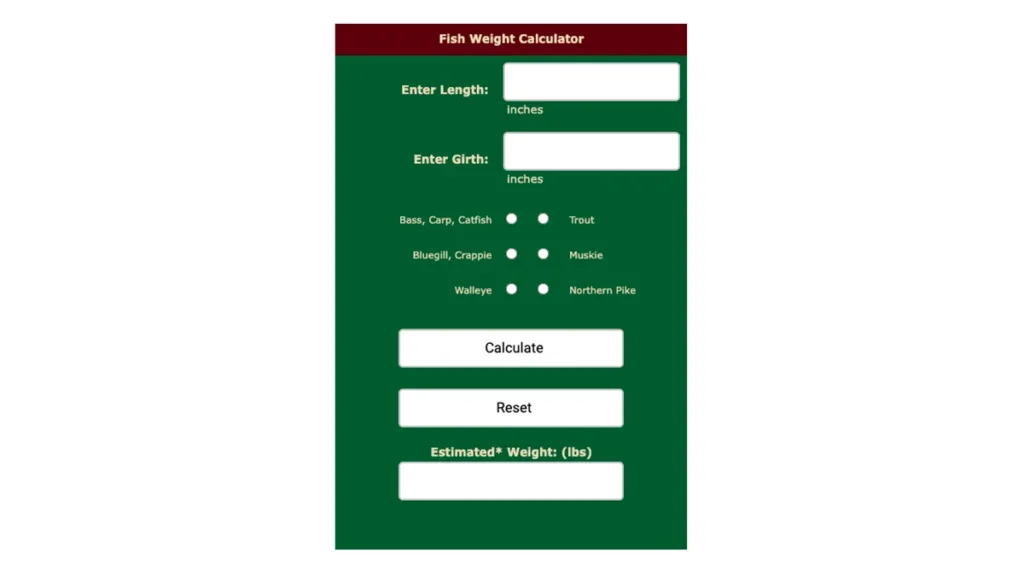
7. Source: Castaic Fishing
- Provides formula based on fork length (tip of mouth to fork in tail, with tail open): length x girth x girth / 800
- Weight: 9.84 pounds
So presumably this 23-inch bass could have weighed just 6 ½ pounds — or close to 10. That’s quite a range! But it’s also true that one 23-inch bass might weigh a good bit more or less than another 23-inch bass, much as a 6-foot-tall dude might weigh 150 or 250. That is, as most bass anglers can attest, some bass are long and skinny; others are considerably chubbier. So formulas that rely only on length, and make no provision for girth, might be suspect.
Using Record Bass to Test Online Weight Calculators
With the hypothetical fish I used above to compare methods, there is no baseline weight to judge which estimates came in on target or far from it. For that reason, I decided to see how length estimators worked with bass of known length and girth.
For that, I went to the IGFA record book, which lists the actual weight of record fish (weighed on certified scales) and the exact length and girth. I plugged in the length and girth figures to see how close to the fish’s actual weight the estimates came in.
I did this for three actual bass world records — first, the all-tackle world-record Florida Bass of 22 pounds, 4 ounces; second the men’s 12-pound tippet record fish, 12 pounds, 15 ounces; and last, the men’s 2-pound tippet bass weighing 8 pounds.
All-Tackle World-Record Florida Bass, Lake Biwa, Japan (2009)

- Length: 27.20 inches
- Girth: 26.77 inches
- Actual weight: 22.25 pounds
Estimated Weights
- Weight per Florida FWC: 17.8 pounds
- Weight per Texas PWD: 12.94 pounds
- Weight per In-Fisherman: 11.95 pounds
- Weight per Castaic Fishing: 24.4 pounds
- Weight per Wisconsin DNR: 16.5 pounds
- Weight per Bass Resource: 19.42 pounds
- Weight per Fish Calculator: 16.3 pounds
Comments: First, clearly most of these weight charts and formulas generally didn’t provide particularly accurate results. If he relied upon these, the angler would have had no idea he’d caught an all-tackle-record fish, as most results came in far too light. Two estimates were close. I suspect the larger and more “girthy” a fish grows, the harder it is for usual estimates to get it right, and this fatty was nearly as big around as it was long.
IGFA Men’s 2-Pound-Line-Class Largemouth Bass
- From Castaic Lake, California (1992)
- Length: 25.0 inches
- Girth: 23.75 inches
- Actual weight: 14 pounds, 12 ounces
Estimated Weights
- Weight per Florida FWC: 13.16 pounds (formula)
- Weight per Texas PWD: 9.75 pounds (chart, length only)
- Weight per In-Fisherman: 9.35 pounds
- Weight per Castaic Fishing: 17.63 pounds (formula)
- Weight per Wisconsin DNR: 12.47 pounds (formula)
- Weight per Bass Resource: 14.55 pounds (calculator, formula not provided)
- Weight per Fish Calculator: 11.80 pounds (formula)
Comments: With this more moderate-sized bass (still a trophy for sure), estimates ranged widely. As with the all-tackle record fish, it seems that most methods estimate a good bit lighter than the real thing.
IGFA Men’s 2-Pound Tippet Florida Bass
- From Pennsylvania, 2001
- Length: 23.8 inches
- Girth: 18.3 inches
- Actual weight: 8 pounds
Estimated Weights
- Weight per Florida FWC: 8.85 pounds (formula)
- Weight per Texas PWD: 7.95 pounds (chart, length only)
- Weight per In-Fisherman: 8.21 pounds (chart, length only and only whole numbers, so based on 24.0 inches)
- Weight per Castaic Fishing: 9.96 pounds (formula)
- Weight per Wisconsin DNR: 8.64 pounds (formula)
- Weight per Bass Resource: 10.16 pounds (calculator, formula not provided)
- Weight per Fish Calculator: 6.64 (formula)
Comments: This last example was a smaller fish and one that was proportionately more slender (smaller girth); interestingly, the estimates — while still often well over or under actual weight — were generally much closer to that actual weight than with either of the larger bass in preceding two examples.
Looking at all three real-world results, it’s interesting that no one system of the seven provided the closest estimate to real weight more than once. So from this limited test, it’s hard to say any one method is “best.” For larger, chunkier bass, the Bass Resource calculator may provide somewhat more reliable results.
What About Smallies?

You can find some but fewer weight-estimation charts or formulas online for smallmouth vs. largemouth bass. The bottom line seems to be that the results are similar, and given the discrepancies among methods for largemouth, these same methods may work just about as well for smallies. But in general, smallmouth will be slightly heavier for a given length than largemouth, which makes sense since they tend to be stouter.
The In-Fisherman chart was one of the few that offered estimation of both species. A couple of examples from this chart:
- 18-inch largemouth = 3.28 pounds
- 18-inch smallmouth = 3.36 pounds
- 24-inch largemouth = 8.21 pounds
- 24-inch smallmouth = 8.43 pounds
IGFA Makes It Easy
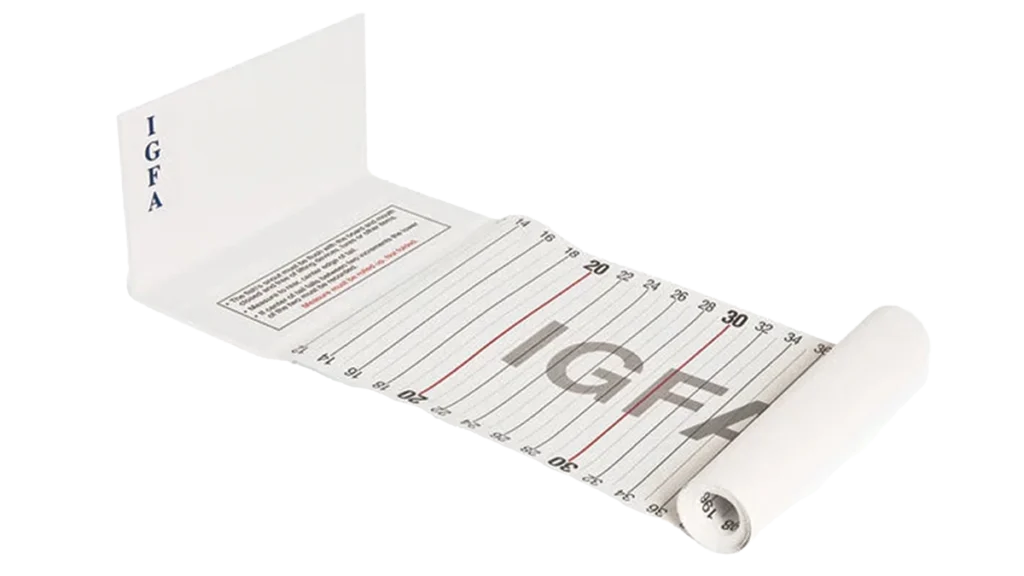
To get a length measurement quickly and accurately, consider the IGFA’s “Official World Record Measuring Device” — a wide roll-up tape measure with a nose-stop against which to place fish. It’s available from the IGFA for $55. Note that while the most accurate weight estimate will come from a combination of length and girth, for the purposes of applying for IGFA length records, only the fish’s length is required.
Lacking this device or any sort of tape measure, simply use a piece of fishing line or leader stretched from nose to end of tail and cut it accordingly for later sizing it against an actual tape measure. The same should be done to get the fish’s girth.
